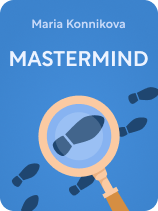

This article is an excerpt from the Shortform book guide to "Mastermind" by Maria Konnikova. Shortform has the world's best summaries and analyses of books you should be reading.
Like this article? Sign up for a free trial here.
How does Detective Sherlock Holmes consistently crack the toughest cases? Is his extraordinary intellect purely fictional, or is it possible to emulate his way of thinking?
In Mastermind: How to Think Like Sherlock Holmes, Maria Konnikova explores the legendary detective’s thought process. She breaks down Holmes’s approach into four key steps, showing how anyone can improve their critical thinking and problem-solving skills.
Keep reading to discover how you can train your mind to think more like Sherlock Holmes.
Overview of Mastermind: How to Think Like Sherlock Holmes
In Mastermind: How to Think Like Sherlock Holmes, psychologist and journalist Maria Konnikova demystifies Holmes’s legendary intellect. She argues that with self-awareness and practice, you can cultivate his cognitive abilities to improve your memory, sharpen your observation skills, and think more rationally.
Konnikova breaks down Holmes’s approach to cracking a case into four steps:
- Maintain an efficient memory archive: Holmes meticulously organizes his extensive knowledge base, constantly updating it with new and relevant information. This maximizes his ability to recall relevant knowledge and draw connections between seemingly disparate pieces of information.
- Observe the evidence: Holmes applies objective observation techniques to note every detail about the case, uncovering both obvious and subtle clues.
- Imagine plausible scenarios: Drawing upon both his existing knowledge base and his observations about the case, Holmes imagines multiple scenarios that might explain the mystery.
- Make a logical deduction: Holmes critically assesses the validity of each scenario, eliminating those that don’t align with the evidence until only the most logically consistent explanation emerges.
(Shortform note: Several authors have dissected Holmes’s investigative method. While they all acknowledge these four steps in their analysis, they each emphasize different stages of Holmes’s process. For example, Stewart Ross (The Science of Sherlock Holmes) highlights the intricacy of Holmes’s objective evidence-gathering, suggesting that he moves beyond simply documenting facts to include a rich, interpretive understanding of the case’s backdrop. Meanwhile, James O’Brien (The Scientific Sherlock Holmes) stresses the concrete, empirical roots of Holmes’s logical deductions, implying that Holmes’s conclusions, while indicative of brilliant reasoning, are also firmly anchored in the precise field of forensic science.)
Konnikova suggests that Holmes can effectively follow these steps because, unlike most people, he’s trained himself to think consciously by default. She explains that your brain comprises two modes of thought—autopilot and conscious:
- Autopilot: This is the default, energy-saving mode that people tend to rely on. It functions rapidly and instinctually, using shortcuts to process information. Because this mode of thinking requires minimal conscious effort, it often leads to inaccurate judgments.
- Conscious: This is the mode of thinking Holmes has trained himself to use all of the time. It functions more slowly than autopilot mode, enabling you to actively evaluate information, form accurate judgments, and solve complex problems. Despite its many benefits, people tend to avoid using this mode because it requires mental effort.
Konnikova argues that the key to thinking more like Holmes is to adopt conscious thinking as your default mode.
(Shortform note: Malcolm Gladwell (Blink) offers a contrasting perspective, arguing that autopilot mode isn’t a mental drawback but an essential tool for efficiently managing mental resources and decision-making. He warns that constant conscious thinking can inhibit this natural mechanism, resulting in mental stagnation. Supporting his argument, he refers to people with damage to their ventromedial prefrontal cortex (a brain region responsible for unconscious thought). These people can’t engage autopilot mode, which means they must always think consciously. However, instead of reaping the benefits Konnikova describes, they tend to overthink, become excessively rational, and struggle to make trivial decisions.)
We’ll walk you through Holmes’s approach and explore how each step relates to your daily decisions and behaviors. We’ll cover common cognitive errors that result from thinking on autopilot and strategies for overriding them and completing each step more consciously.
Step #1: Maintain an Efficient Memory Archive
Holmes’s insights into cases stem from his ability to accurately recall relevant information from his extensive knowledge base. Konnikova notes that Holmes achieves this by continually organizing his memories—consciously memorizing details that may aid his investigations. This ongoing memory curation provides him with a well-organized mental archive of relevant information, allowing him to effectively integrate and apply his knowledge to solve complex cases. We’ll first explain how the autopilot mode of thinking hampers memory storage and recall. Then we’ll explore how to consciously create new memories.
Autopilot Mode Impedes Memory Storage and Recall
Unlike Holmes, most people don’t consciously manage their memories. Rather, they let their brains operate on autopilot, resulting in a disorganized memory archive that hampers their ability to retain and recall information. Konnikova explains that when you’re in this mode, your brain automatically stores information based on what immediately appeals to you—whether it’s personally interesting, emotionally stimulating, or novel. This indiscriminate accumulation leads to a chaotic memory archive where the things you want to remember get buried under heaps of trivia, making it difficult to recall information when you need it.
How to Consciously Create New Memories
Konnikova suggests that you can emulate Holmes’s memory management skills by taking conscious control of the information you commit to memory. She recommends four strategies for achieving this: Set clear goals, fuel your motivation, create associations, and engage your senses.
Strategy 1) Set Clear Goals
Konnikova advises that you determine what information is relevant to your objectives and focus only on those details to avoid cluttering your memory archive with unnecessary data. For example, when studying for an exam, focus on the concepts likely to be tested rather than trying to memorize every single point in the textbook.
Strategy 2) Fuel Your Motivation
Consider what benefits remembering the information will provide. Konnikova says that being clear about the advantages will encourage you to engage more deeply with—and thus effectively memorize—the material. For example, if you need to remember names at a networking event, think about how each person could play a role in your professional development, thereby giving each name a personal stake in your memory.
Strategy 3) Create Associations
Link your existing knowledge with what you want to remember. According to Konnikova, this leverages your brain’s tendency to organize and retrieve memories through networks of related concepts. When you associate new data with what you already know, you weave it into your brain’s existing network of memories, thereby enhancing retrieval. For example, to remember a new acquaintance’s name, associate it with a friend or celebrity who shares the same name.
Strategy 4) Engage Your Senses
Engage your senses when reviewing what you want to remember—for instance, by describing the information aloud or vividly imagining the details. Konnikova explains that multisensory stimulation forces you to process new information more thoroughly, leading to more effective retention and recall. For example, to engage your senses to remember a recipe, you might speak the steps out loud, visualize yourself performing each action, imagine the taste of the ingredients, the smell of the dish cooking, or gesture the movements as if you were cooking.
Step #2: Observe the Evidence
We’ve just covered how taking conscious control of what you commit to memory helps you accurately recall relevant information when needed. Now, let’s move on to the second step of Holmes’s process: Observe the evidence.
Holmes’s keen eye for detail enables him to notice subtle clues that escape the notice of others. Konnikova suggests that the key to Holmes’s ability is his continual, mindful awareness of his mental processes and environment. His heightened awareness allows him to objectively take in all the evidence, ensuring that he doesn’t overlook crucial details or allow irrelevant distractions to mislead him.
This mindful approach is critical to his investigative success because his observations directly influence the information he retrieves from his memory, how he interprets the evidence, and his subsequent deductions. Likewise, Konnikova points out that your observations impact how you interpret and judge your environment, which in turn influences all your subsequent thoughts, decisions, and behaviors. We’ll now explain how the autopilot mode of thinking interferes with accurate observation and how you can consciously control what you observe.
Autopilot Mode Obstructs Accurate Observation
In contrast to Holmes’s mindful approach, operating on autopilot predisposes you to cognitive shortcuts that prioritize quick, effortless perception at the expense of accuracy. Konnikova explains that these shortcuts essentially filter your perceptions, making it impossible to objectively observe your environment. This leads you to base all your subsequent thoughts, decisions, and behaviors on skewed or incomplete observations.
According to Konnikova, several factors make you more susceptible to cognitive shortcuts and inaccurate observations.: distractions, priming, environmental conditions, your internal state, and biases. Let’s explore these in detail.
Factor 1) Distractions
Konnikova argues that distractions make it impossible to focus on or accurately observe anything. As a result, you overlook details in your environment. For example, while multitasking in a grocery store—talking on your phone and scanning the shelves—you might overlook a “Caution: Wet Floor” sign, resulting in a preventable accident.
Factor 2) Priming
Konnikova suggests that priming—where recent stimuli narrow your focus—compels you to notice details that align with those stimuli and ignore those that don’t. For example, after seeing an advertisement for a specific car model, you start noticing that car model more frequently, while other models fade into the background.
Factor 3) Environmental Conditions
According to Konnikova, environmental conditions influence what you notice. For example, a gloomy day might dim your perception of your surroundings, causing you to miss the vibrant colors of a street mural that would usually catch your eye on a sunnier day.
Factor 4) Your Internal State
Konnikova explains that internal factors such as your mood or physical state skew your perception of events. For example, when you feel positive and energetic, you’re more likely to pick up on useful information in a work meeting. On the other hand, when you feel tired or unwell, you’re more likely to perceive that same meeting as banal and fail to note valuable insights.
Factor 5) Biases
According to Konnikova, biases stemming from entrenched stereotypes and past experiences lead you to only observe details that fit your preconceived notions and ignore any evidence that doesn’t fit. For example, if you believe that bankers are corrupt, you might only notice financial scandals and disregard reports of bankers working ethically.
How to Consciously Control What You Observe
Konnikova suggests that you can overcome the influence of cognitive shortcuts and make more accurate observations by adopting a three-part strategy: Define your purpose, engage all your senses, and recognize and challenge cognitive shortcuts.
Strategy 1) Define Your Purpose
Begin by clearly defining the purpose of your observation. Konnikova explains that this intentional focus instructs your brain to consciously filter stimuli based on your objectives. This makes it easier for you to notice what’s relevant and ignore what’s not. For example, you define improving customer satisfaction as the purpose of your observation and choose to zero in on customer interactions and feedback mechanisms.
Strategy 2) Engage All Your Senses
With your purpose in mind, bring all of your senses into play to observe your environment. Konnikova says that a multisensory approach enables you to consciously capture nuances and details that you might otherwise overlook. For example, the purpose of your observation is to gauge your child’s mood. Instead of just asking them how their day was and listening to their verbal response, observe their body language and energy levels, notice if they’re tense or relaxed when you hug them, or pay attention to their energy levels and appetite during dinner. All these sensory inputs will provide a more complete picture of their emotional state than words alone could convey.
Strategy 3) Recognize and Challenge Cognitive Shortcuts
Even with a clear purpose and active sensory engagement, cognitive shortcuts can still influence your observations. To counter this influence, Konnikova recommends the following methods:
1) Before making an observation, pause and reflect on possible internal and environmental influences on your observations. This preemptive contemplation can help you anticipate and mitigate influences before they affect your perception. For example, before reviewing a report, consider any factors that might affect your attention to detail, such as your energy level or the lighting in your office.
2) Use checklists to systematically guide your observations. According to Konnikova, this structured approach prevents autopilot from taking over and filtering critical details. For example, if you’re shopping for a new refrigerator, use a checklist to ensure you don’t overlook essential features like energy efficiency ratings, dimensions, noise levels, and warranty details.
3) After making an observation, consider how preconceived notions may have influenced it. Konnikova says that this reflection ensures that your observations are based on facts rather than assumptions. For example, after conversing with a neighbor, reflect on whether your observations were colored by your previous experiences with them, rather than what was actually said in this conversation.
4) Recount your observations as if explaining them to someone unfamiliar with the situation. Konnikova suggests that this practice can highlight overlooked details and provide a clearer, more objective view. For example, by describing a team meeting to a colleague who wasn’t present, you might realize that you noticed contributions from more vocal members and overlooked valuable input from quieter team members.
Step #3: Imagine Plausible Scenarios
Now that we’ve discussed how to overcome the influence of cognitive shortcuts to make more accurate observations, let’s explore the third step of Holmes’s process: Imagine plausible scenarios.
Instead of jumping to conclusions, Holmes constructs a variety of potential narratives to explain the mystery. How is it that Holmes can conceive multiple possibilities while others on the case either struggle to move past their initial assumptions or fail to propose a single theory? According to Konnikova, he engages in creative thinking, using his imagination to synthesize his knowledge with the evidence he’s observed and to explore patterns and connections between seemingly disparate clues.
Konnikova argues that this imaginative process is vital to Holmes’s investigative success and is also critical for effective decision-making and problem-solving in daily life. We’ll explain how the autopilot mode of thinking inhibits creative problem-solving and how to more consciously engage your imagination.
Autopilot Mode Compels You to Jump to Conclusions
Contrary to Holmes’s imaginative and exploratory approach, operating on autopilot compels you to latch onto the first conclusion or solution that comes to mind. Konnikova explains that just as it predisposes you to cognitive shortcuts, autopilot streamlines your decision-making and problem-solving processes at the expense of thoroughness. This streamlining process nudges you to favor ideas that align with your preconceptions and expectations and to dismiss those that don’t. As a result, you automatically settle for the most obvious or convenient answers and solutions, regardless of their accuracy or effectiveness.
How to Consciously Engage Your Imagination to Cultivate Fresh Ideas
Konnikova says that you can override the tendency to make quick decisions, cultivate Holmes’s ability to think outside of the box, and open your mind to new possibilities by practicing six strategies: Challenge your initial assumptions, embrace new ideas and experiences, expand your knowledge, practice mindfulness, engage in constructive distractions, and change your environment.
Strategy 1) Challenge Your Initial Assumptions
Actively seek out contradictory information and perspectives. According to Konnikova, this deliberate search can expose flaws in your initial assumptions and point you toward viable alternatives. For example, if you’re deciding how to reduce operational costs and your first instinct is to cut staff, investigate companies that have achieved cost savings in other ways.
Strategy 2) Embrace New Ideas and Experiences
Konnikova highlights that exposing yourself to unfamiliar ideas and diversifying your experiences forces your brain to consider a wider range of possibilities, which curbs your tendency to settle for convenient answers. For example, if you’re planning a vacation and automatically think of visiting a popular resort, researching less well-known destinations might lead you to a more adventurous and memorable holiday.
Strategy 3) Expand Your Knowledge
Cultivate knowledge across different fields. Konnikova explains that the wider your learning, the easier it is to identify patterns and relationships that are not immediately obvious. For example, your basic knowledge of economic theory may lead you to assume that the only way a business can get more customers is by lowering prices. However, by reading up on social psychology, you might realize that fostering a sense of community can be just as effective.
Strategy 4) Practice Mindfulness
Konnikova suggests that mindfulness practices such as meditation enhance creative thinking by detaching your mind from the issue at hand, as well as from other distractions. This creates mental space to consider decisions or problems from a broader, more conceptual standpoint and allows you to explore ideas that might have been obscured by a narrow focus on details. For example, you’ve been grappling with a complex coding problem and feel stuck. After a mindfulness session, you return to the problem with a relaxed mind. This helps you realize that the issue isn’t in the code itself but in the way users are interacting with it, prompting a redesign that resolves the issue and enhances user experience.
Strategy 5) Engage in Constructive Distractions
Take a break from directly focusing on the issue by immersing yourself in an engaging yet undemanding activity. Konnikova notes that this kind of distraction enables your brain to process the problem or decision in the background. This allows your mind to make connections and access ideas that aren’t readily available during intense, focused thought. For example, when putting together a jigsaw puzzle—an activity unrelated to the speech you’re trying to write—you might recall a personal anecdote that perfectly illustrates your main point.
Strategy 6) Change Your Environment
Switch up the environment where you usually address the decision or problem you’re facing—for instance, by relocating to a new room or going for a walk. Konnikova notes that new surroundings offer varied sensory experiences that nudge your brain to think differently. For example, if you’re suffering from writer’s block, moving from your usual workspace to a bustling café might surround you with a lively atmosphere, sparking a flow of fresh phrases and concepts that rejuvenate your writing.
Step #4: Make a Logical Deduction
We’ve just explained how to override the tendency to make snap judgments and open your mind to alternative possibilities. We’ll now discuss Holmes’s fourth and final step of the process: Make a logical deduction.
Holmes critically evaluates each scenario against the evidence to deduce the most logical explanation. Konnikova argues that Holmes’s consistent success in unraveling mysteries stems from his ability to engage in disciplined reasoning that is both sequential and exhaustive. This meticulous approach ensures that his final deduction is not just one of many plausible theories, but the only explanation that accounts for all of the evidence.
Konnikova emphasizes that disciplined reasoning is just as critical for everyday decision-making and problem-solving because it safeguards against errors that can lead to poor judgment. Next, we’ll explain how autopilot mode inhibits logical thinking and explore strategies to reach rational conclusions.
Autopilot Mode Favors Intuition Over Logic
Counter to Holmes’s logical approach, when you operate in autopilot mode, you’re more likely to favor intuition over analytical thinking because following your gut demands less cognitive effort than the rigorous process of logical reasoning.
Konnikova explains that, in autopilot mode, your brain seeks to quickly make sense of new information by drawing parallels with past experiences or existing knowledge. The ease of making these connections can create a compelling sense of rightness. This feeling urges you to disregard evidence that doesn’t conform to these preexisting frameworks. As a result, you form conclusions that feel comfortable and reassuring due to their familiarity, rather than conclusions that are factually sound.
For example, when house hunting, you gravitate toward a property similar to your childhood home despite it being smaller and pricier than other options. The logical approach would be to consider more cost-effective properties, but you quickly conclude that it’s the best property for you because it feels familiar and right.
How to Consciously Formulate Logical Conclusions
According to Konnikova, you can formulate more logical conclusions and overcome the tendency to rely on intuition by adopting a three-part strategy: Weigh all evidence equally, follow a logical sequence, and review and revise. Let’s explore how you can apply these strategies to assess the viability of each potential conclusion (your results from Step #3, imagining plausible scenarios).
Strategy 1) Weigh All Information Equally
Approach all information with impartiality, assigning equal weight to evidence that supports or challenges your theory. Konnikova suggests that consciously giving equal consideration to all available data counteracts your natural inclination to seek out and prioritize information that confirms your initial assumptions (as discussed in Step #2, observe the evidence). For example, if you assume that an investment will pay off, analyze both its potential growth based on past performance and factors that may challenge your assumption, such as market volatility and economic forecasts.
Strategy 2) Follow a Logical Sequence
Analyze the information systematically, ensuring that each inference logically follows from the one before it. Konnikova explains that this step-by-step approach helps you clarify the connections between different pieces of information. Additionally, it ensures a clear line of reasoning, where each inference lays the groundwork for the next, leading to a well-reasoned conclusion that’s factually grounded.
For example, to understand why a marketing campaign failed, begin with the initial market research to see if the target demographic was identified correctly. Then, move on to the strategy developed from that research, checking if it aligned with the research insights. Next, evaluate the execution of the campaign to ensure it was carried out as planned. Finally, analyze the campaign results against the expected outcomes. This sequential analysis ensures a logical connection between each phase and helps pinpoint where the plan may have gone awry.
Strategy 3) Review and Revise
Continuously evaluate and adjust your conclusions in light of new data or perspectives. Konnikova emphasizes that a logical deduction is not a one-time event but an ongoing process that should evolve as and when new information emerges. This active revision helps eliminate outdated information, ensuring your conclusions align with the latest relevant facts. For example, you’ve concluded that your business strategy should focus on product innovation to outpace competitors. If new information reveals a market shift toward customer experience enhancements, revisiting and revising your conclusion will ensure a more competitive strategy.

———End of Preview———
Like what you just read? Read the rest of the world's best book summary and analysis of Maria Konnikova's "Mastermind" at Shortform.
Here's what you'll find in our full Mastermind summary:
- The specific mental strategies Sherlock Holmes uses to unravel mysteries
- Why most people don’t think like Sherlock Holmes
- How to improve your memory, sharpen your observation skills, and think more rationally






